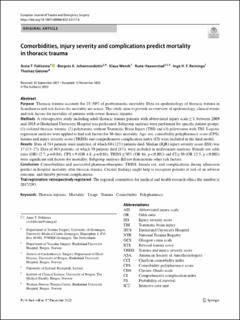| dc.contributor.author | Fokkema, Anne T. | |
| dc.contributor.author | Johannesdottir, Bergros Kristin | |
| dc.contributor.author | Wendt, Klaus | |
| dc.contributor.author | Haaverstad, Rune | |
| dc.contributor.author | Reininga, Inge H. F. | |
| dc.contributor.author | Geisner, Thomas | |
| dc.date.accessioned | 2023-01-30T12:38:50Z | |
| dc.date.available | 2023-01-30T12:38:50Z | |
| dc.date.created | 2023-01-02T17:28:40Z | |
| dc.date.issued | 2022 | |
| dc.identifier.issn | 1863-9933 | |
| dc.identifier.uri | https://hdl.handle.net/11250/3047105 | |
| dc.description.abstract | Purpose
Thoracic trauma accounts for 25–50% of posttraumatic mortality. Data on epidemiology of thoracic trauma in Scandinavia and risk factors for mortality are scarce. This study aims to provide an overview of epidemiology, clinical events and risk factors for mortality of patients with severe thoracic injuries.
Methods
A retrospective study including adult thoracic trauma patients with abbreviated injury scale ≥ 3, between 2009 and 2018 at Haukeland University Hospital was performed. Subgroup analyses were performed for specific patient groups: (1) isolated thoracic trauma, (2) polytrauma without Traumatic Brain Injury (TBI) and (3) polytrauma with TBI. Logistic regression analyses were applied to find risk factors for 30-days mortality. Age, sex, comorbidity polypharmacy score (CPS), trauma and injury severity score (TRISS) and comprehensive complication index (CI) were included in the final model.
Results
Data of 514 patients were analyzed, of which 60 (12%) patients died. Median (IQR) injury severity score (ISS) was 17 (13–27). Data of 463 patients, of which 39 patients died (8%), were included in multivariate analyses. Female sex odds ratio (OR) (2.7, p = 0.04), CPS > 9 (OR 4.8; p = 0.01), TRISS ≤ 50% (OR 44; p < 0.001) and CI ≥ 30 (OR 12.5, p < 0.001) were significant risk factors for mortality. Subgroup analyses did not demonstrate other risk factors.
Conclusion
Comorbidities and associated pharmacotherapies, TRISS, female sex, and complications during admission predict in-hospital mortality after thoracic trauma. Current findings might help to recognize patients at risk of an adverse outcome, and thereby prevent complications. | en_US |
| dc.language.iso | eng | en_US |
| dc.publisher | Springer | en_US |
| dc.rights | Navngivelse 4.0 Internasjonal | * |
| dc.rights.uri | http://creativecommons.org/licenses/by/4.0/deed.no | * |
| dc.title | Comorbidities, injury severity and complications predict mortality in thoracic trauma | en_US |
| dc.type | Journal article | en_US |
| dc.type | Peer reviewed | en_US |
| dc.description.version | publishedVersion | en_US |
| dc.rights.holder | Copyright 2022 The Author(s) | en_US |
| cristin.ispublished | true | |
| cristin.fulltext | original | |
| cristin.qualitycode | 1 | |
| dc.identifier.doi | 10.1007/s00068-022-02177-6 | |
| dc.identifier.cristin | 2099130 | |
| dc.source.journal | European Journal of Trauma and Emergency Surgery | en_US |
| dc.identifier.citation | European Journal of Trauma and Emergency Surgery. 2022. | en_US |

